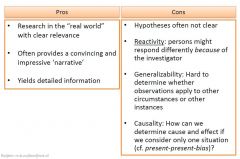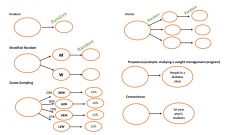![]()
![]()
![]()
Use LEFT and RIGHT arrow keys to navigate between flashcards;
Use UP and DOWN arrow keys to flip the card;
H to show hint;
A reads text to speech;
21 Cards in this Set
- Front
- Back
- 3rd side (hint)
|
Participant observation |

|
|
|
|
Naturalistic observation |
Field study |
|
|
|
Direct observation |
With direct, systematic, observation of behavior: – People are put in a particular situation – Their behavior in that situation is observed – Observation typically involves a protocol – The protocol allows scoring of how often or to what extend a particular behavior is displayed |
• Research has shown that babies often don’t recognize changes in their sight • This is called ‘change blindness’ • Hypothesis: adults also suffer from change blindness |
|
|
structured observation |
• In this example, observations are relatively straightforward: does the person notice the change? • Typically, the observation follows a clear protocol that describes how particular behaviors are to be scored. |
• Conditions under which behavior is observed are controlled by the researcher • We can check inter-rater reliability • And the procedure can be replicated: used in different or in the same context repeatedly to study generalizability • By varying conditions we can also study causal factors |
|
|
Observer bias |
• We see what we want to see! • Observation is an active process that can be heavily influenced by expectations Observer bias occurs when: • The observer assesses the situation incorrectly |
|
|
|
Solutions observer bias |
• Objective and unambiguous scoring protocols • Interrater reliability or interobserver reliability: Do different observers observe the same things independently from each other? |
|
|
|
Blind study |
Experimenter does not know who is assigned to which condition |
|
|
|
Double-blind study |
– Experimenter does not know who is assigned to which condition – Participant does not know to which condition (s)he is assigned to |
|
|
|
Placebo-controlled Double-blind study |
– Experimenter does not know who is assigned to which condition – Participant does not know to which condition (s)he is assigned to – Those in control group receive placebo treatment |
|
|
|
Observer effects |
• When the observer influences the behavior in such a way that it becomes in line with the hypothesis |
|
|
|
Reactivity |
When the observer influences behavior |
|
|
|
Rosenthal effect / Pygmalion effect |
higher expectations lead to an increase in performance |
|
|
|
Solutions observer effects & reactivity |
1. Hide: ensure that participants are unaware of being observed 2. Wait it out: wait until participants are accustomed to being observed 3. Deceive: lead participants to believe that they are not being observed (or that you’re interested in something else) 4. Use unobtrusive measures: look not at behavior but rather at effects or outcomes of that behavior 5. Use blind observers and experimenters: if observers or experimenters do not know what is to be expected, their expectations cannot affect participant’s behaviors |
|
|
|
Sampling bias |
occurs when the sample differs systematically from the target population on relevant variables |
– What are the relevant variables? – What is the target population? |
|
|
SAMPLING |

|
|
|
|
Convenience sampling |
just select participants that happen to be available |
|
|
|
Purposive sampling |
including a selected group that has desirable characteristics |
choose a state that voted similarly to the overall population on the last election |
|
|
Cluster sampling / multi-stage sampling |
1) select a certain cluster of units (e.g., 5 municipalities in a country) randomly 2) randomly select participants within the selected units (e.g., schools). |
|
|
|
Quota sampling %%% |
type of purposive sampling in which one ensures
that each “stratum” is sufficiently represented in sample |
|
|
|
Stratified random sampling |
create strata, and within each stratum randomly select individuals (so each stratum is well-represented within the sample) |
|
|
|
cons of case studies |
Hard to determine causality with only one case (bc of: confounding, present-present bias) • Sensitive to bias (‘observer bias’ en ‘observer effects’) • Poor generalizability: Only with very homogeneous population would one case suffice to understand other cases |
|

